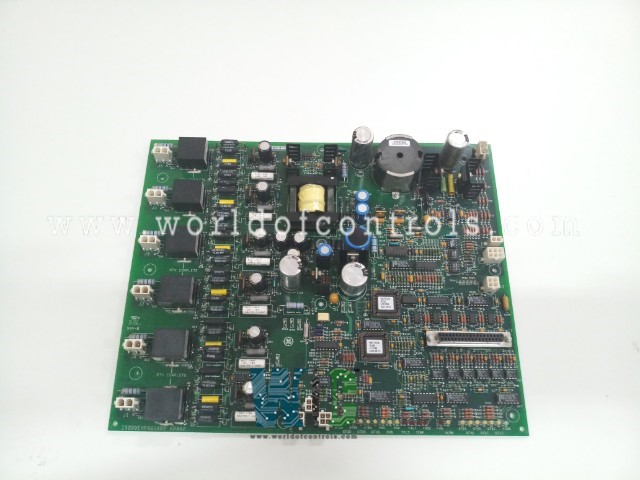SPECIFICATIONS
Part No.: IS200EHPAG1ABB
Manufacturer: General Electric
Country of Manufacture: United States of America (USA)
Temperature Operating: -30 to 65oC
Product Type: Exciter Gate Pulse Amplifier Board
Availability: In Stock
Series: EX2100
Functional Description
IS200EHPAG1ABB is an Exciter Gate Pulse Amplifier Board developed by GE. It is a part of the EX2100 control system. The Gate Pulse Amplifier Board (EHPA) is responsible for receiving gate commands from the ESEL and controlling the gate firing of up to six SCRs on the Power Bridge. Additionally, it serves as the interface for current conduction feedback, as well as monitoring bridge airflow and temperature.
Functionality and I/O
The EHPA functional model encompasses various input and output (I/O) components to facilitate its operations.
- Power Supply: Powered by a nominal 125 V dc power source supplied from the EPDM. An onboard dc/dc converter ensures consistent power supply for SCR gating operations across the full range of input supply voltage.
- LED Indicators: LEDs are incorporated into the design to provide visual indication of various system parameters. These indicators illuminate to denote the status of the EHPA power supply, input gate commands from ESEL, EHPA outputs to the SCRs, currents into the bridge, line filter, cooling fan rotation, bridge temperature, as well as alarms or fault conditions.
- Gate Control and SCR Firing: Receives gate commands from the ESEL and effectively controls the gate firing of up to six SCRs situated on the Power Bridge. This functionality ensures precise control over the excitation process, optimizing performance and stability.
- Bridge Monitoring: Current conduction feedback is facilitated through the EHPA, allowing for monitoring of currents into the bridge. This feedback mechanism aids in maintaining optimal operation and preventing potential issues related to overloading or imbalance.
- Airflow and Temperature Monitoring: The EHPA serves as an interface for monitoring bridge airflow and temperature. This capability enables the system to detect and respond to variations in environmental conditions, ensuring proper cooling and temperature regulation within the power bridge.
Importance of EHPA in EX2100 Excitation Control
- The board's multifaceted functionality and comprehensive I/O capabilities make it an indispensable component of the 100 mm EX2100 Excitation Control system.
- By facilitating precise gate control, providing critical feedback on bridge operation, and enabling real-time monitoring of environmental factors, the EHPA plays a pivotal role in ensuring the reliability, efficiency, and safety of the excitation process.
Installation
- Ensure System De-energization: Before initiating the replacement process, ensure that the excitation system, where the EHPA board is housed, has been completely de-energized to prevent any electrical hazards.
- Safety Precautions: Open the door of the Power Conversion Cabinet and conduct thorough testing of all electrical circuits to confirm that power has been successfully turned off. Take necessary precautions to avoid accidental contact with live circuits.
- Verify LEDs: Check that all LEDs are switched off, indicating that power has been effectively shut down.
- Labeling of Cables: Inspect and ensure that all cables connected to the EHPA board are clearly labeled with the correct connector names, as indicated on the board itself. Proper labeling simplifies the reconnection process.
- Disconnect Cables: With caution, disconnect all cables from their respective connectors on the EHPA board. Handle the cables carefully to avoid damage and ensure smooth reinstallation.
- Removal of the Board: Carefully remove the existing EHPA board from its mounting location within the equipment. Exercise caution to prevent any damage to the board or surrounding components.
- Verification of Replacement Board: Before proceeding with installation, carefully inspect the replacement EHPA board to confirm that all jumpers are correctly positioned, matching the configuration of the original board.
- Installation of Replacement Board:Insert the replacement board into its designated mounting location within the equipment. Ensure proper alignment and secure placement to prevent any loose connections or misalignment issues.
- Reconnection of Cables: Reconnect all cables that were previously disconnected in step 5, ensuring that each cable is securely fastened and properly tightened to its respective connector on the replacement board.
- Final Checks: Once all cables are reconnected, perform a final inspection to verify the integrity of the installation. Double-check the tightness of connections and ensure that no hardware or debris has been left inside the equipment.
The WOC team is always available to help you with your EX2100 requirements. For more information, please contact WOC.
Frequently Asked Questions
What is IS200EHPAG1ABB?
It is an Exciter Gate Pulse Amplifier Board developed by GE under the EX2100 series.
What signals trigger an alarm in the excitation system?
Alarms are generated in the excitation system based on signals from various sources, including the line filter, fans, temperature switches (170 and 190), and RTD exceeding an alarm threshold.
What conditions lead to a temperature trip in the system?
A temperature trip occurs when signals are received from both thermal switches or if the RTD exceeds a specified fault threshold, indicating critical temperature levels.
What are the failure modes that result in bridge shutdown?
Bridge shutdowns occur due to two primary failure modes - a temperature trip or a Gate Pulse Amplifier (GPA) failure. In both single and parallel bridge configurations, the GPA stops gating unless manual coolant trips are disabled.
